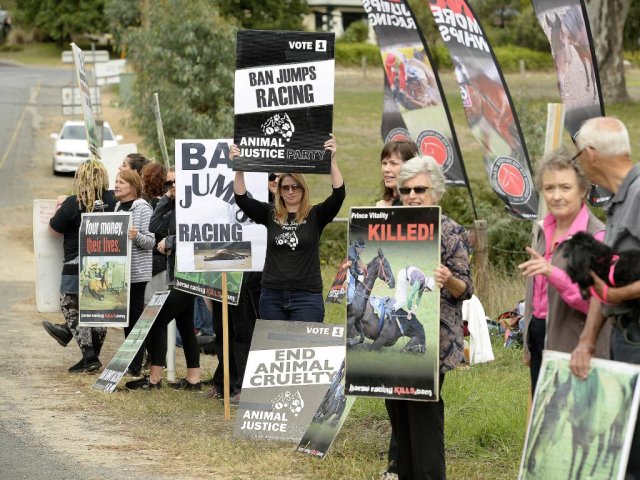
The South Australian Racing Minister Leon Bignell has called on the state’s horseracing authority to ban jumps racing after five-year-old Wheeler Fortune was euthanised on April 15 after falling during the Somerled Hurdle race in Oakbank.
Bignell called on Thoroughbred Racing SA to act, labelling jumps racing “cruel and “barbaric”. But the controlling body said jumps racing was an “integral part” of the sport and would continue.
Jumps racing is the deadliest form of horse racing in Australia. Now only legal in Victoria and South Australia, it involves horses clearing obstacles of at least one metre high, in a pack, at speed, over long distances.
More than 60 horses have died after being injured in a jumps race in South Australia and Victoria in the past eight years.
The statistics show that jumps horses are pushed far beyond their normal limits and are subjected to much greater physical, psychological and physiological stress than flat track racehorses.
The mortality rate of a jumps horse is nearly 19 times higher than those racing on the flat.
One jumps horse dies for every 115 horses that start in a race, compared to one death for every 2150 horses that start in a flat race.
Catastrophic limb injuries are 18 times more likely and head or back and neck injuries are 121 times more likely in jump races than flat races.
Jumps horses are generally older than flat racing horses. Many have raced in flat events and are therefore more likely to have bone, tendon and muscle weaknesses. These horses are then required to race over distances of up to five kilometres and clear more than a dozen jumps.
In 1991, the Senate Select Committee on Animal Welfare produced a report, Aspects of Animal Welfare in the Racing Industry, which said: “Based on evidence received during the inquiry, the Committee has serious concerns about the welfare of horses participating in jumps races. Those concerns are based on the significant probability of a horse suffering serious injury or even death as a result of participating in these events, and in particular, steeplechasing … Accordingly, the Committee is of the view that the relevant state governments should phase out jump racing over the next three years.”
That was 26 years ago.
In 2009, Racing Victoria announced it would abolish jumps racing at the conclusion of the 2010 season. Early in 2010, the decision was reversed and jumps events have continued to be sanctioned, despite then-Victorian Racing Minister, Rob Hulls, publically stating concern over the welfare of horses in jumps racing.
New South Wales, where Australia’s first jumps event was held in 1832, banned jumps racing in 1997. The Tasmanian racing industry voluntarily stopped holding jumps events in 2007. Western Australia has not held jumps races since 1941, while the ACT and Queensland have only ever held occasional events.
Bignell said on April 17 that many racing clubs and members did not want jumps events anymore but Thoroughbred Racing SA was forcing clubs to host them.
“Racing horses over jumps poses an unacceptable risk to both horses and riders. It’s cruel, it’s barbaric and it doesn’t belong in the 21st century. It is time for [Thoroughbred Racing SA] to act and ban jumps racing,” he said.
Thoroughbred Racing SA chair Frances Nelson replied by pointing to the income it generates. “It’s an integral part of our industry,” she said. “This carnival alone, over two days of Easter, puts $13m into the local economy.”
Dozens of protesters outside the event said deaths like Wheeler Fortune’s show the sport should be banned.
Elio Celotto from the Coalition for the Protection of Racehorses said: "We know that jumps racing cannot be made safe. We know the number of falls is still as statistically high as they have [ever] been.”
Oakbank Racing Club chairman Barney Gask said Wheeler Fortune’s death was the first fatality at the track in six years. But the RSPCA disputed this, saying Wheeler Fortune was the fourth horse to die in that period.
The RSPCA SA’s Rebecca Eyers said forcing horses to gallop long distances while jumping over obstacles was a “recipe for this kind of tragedy”. “It will keep occurring as long as we continue to allow it.”
Like the article? Subscribe to Green Left now! You can also like us on Facebook and follow us on Twitter.